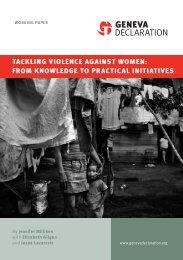Global Burden of Armed Violence - The Geneva Declaration on ...
Global Burden of Armed Violence - The Geneva Declaration on ...
Global Burden of Armed Violence - The Geneva Declaration on ...
Create successful ePaper yourself
Turn your PDF publications into a flip-book with our unique Google optimized e-Paper software.
<str<strong>on</strong>g>The</str<strong>on</strong>g> absence <str<strong>on</strong>g>of</str<strong>on</strong>g> data makes it difficult to compare<br />
extrajudicial killings across time and space. One<br />
element <str<strong>on</strong>g>of</str<strong>on</strong>g> violence reducti<strong>on</strong> policies, however,<br />
could include improving reporting rates, enhanc-<br />
ing access to legitimate justice mechanisms, and<br />
providing meaningful protecti<strong>on</strong>. At the most basic<br />
level, the pooling <str<strong>on</strong>g>of</str<strong>on</strong>g> informati<strong>on</strong> <strong>on</strong> extrajudicial<br />
killings by the special rapporteur and human rights<br />
organizati<strong>on</strong>s could be <strong>on</strong>e step forward in gen-<br />
erating awareness <str<strong>on</strong>g>of</str<strong>on</strong>g> the frequency and magnitude<br />
<str<strong>on</strong>g>of</str<strong>on</strong>g> this form <str<strong>on</strong>g>of</str<strong>on</strong>g> armed violence.<br />
Disappearances<br />
Typically described as ‘enforced disappearances’,<br />
such acts c<strong>on</strong>stitute yet another facet <str<strong>on</strong>g>of</str<strong>on</strong>g> illegitimate<br />
armed violence. In certain cases, disappearance<br />
may include the eventual killing <str<strong>on</strong>g>of</str<strong>on</strong>g> the pers<strong>on</strong> who<br />
is abducted. In many cases, the victim’s family<br />
does not know whether the disappeared pers<strong>on</strong><br />
is alive, c<strong>on</strong>tributing to their pain and suffering.<br />
Disappearances are also frequently linked to<br />
criminal violence, including social cleansing; execu-<br />
ti<strong>on</strong>s; displacement; and, in certain circumstances,<br />
rape, sexual violence, and forced recruitment.<br />
<str<strong>on</strong>g>The</str<strong>on</strong>g> category <str<strong>on</strong>g>of</str<strong>on</strong>g> ‘enforced disappearances’ is<br />
invoked by human rights specialists to describe<br />
violence by state <str<strong>on</strong>g>of</str<strong>on</strong>g>ficials. While excepti<strong>on</strong>s exist,<br />
the term does not usually refer to disappearances<br />
committed by n<strong>on</strong>-state actors. 6 <str<strong>on</strong>g>The</str<strong>on</strong>g> illegitimacy<br />
<str<strong>on</strong>g>of</str<strong>on</strong>g> such acti<strong>on</strong>s is enshrined in a number <str<strong>on</strong>g>of</str<strong>on</strong>g> legal<br />
instruments, including the 2006 Internati<strong>on</strong>al<br />
C<strong>on</strong>venti<strong>on</strong> for the Protecti<strong>on</strong> <str<strong>on</strong>g>of</str<strong>on</strong>g> all Pers<strong>on</strong>s<br />
from Enforced Disappearances. Included in the<br />
definiti<strong>on</strong> are those who suffer:<br />
arrest, detenti<strong>on</strong>, abducti<strong>on</strong> or any other form <str<strong>on</strong>g>of</str<strong>on</strong>g><br />
deprivati<strong>on</strong> <str<strong>on</strong>g>of</str<strong>on</strong>g> liberty by agents <str<strong>on</strong>g>of</str<strong>on</strong>g> the State or<br />
by pers<strong>on</strong>s or groups <str<strong>on</strong>g>of</str<strong>on</strong>g> pers<strong>on</strong>s acting with the<br />
authorizati<strong>on</strong>, support or acquiescence <str<strong>on</strong>g>of</str<strong>on</strong>g> the<br />
Box 7.3 Gender-based violence by state <str<strong>on</strong>g>of</str<strong>on</strong>g>ficials<br />
State security and justice agencies bear the resp<strong>on</strong>sibility to protect citizens<br />
and to ensure the protecti<strong>on</strong> <str<strong>on</strong>g>of</str<strong>on</strong>g> human rights and the maintenance <str<strong>on</strong>g>of</str<strong>on</strong>g> public<br />
order. However, all too <str<strong>on</strong>g>of</str<strong>on</strong>g>ten, these agencies are involved in gender-based<br />
violence (GBV) in the executi<strong>on</strong> <str<strong>on</strong>g>of</str<strong>on</strong>g> their tasks. GBV occurs either through<br />
discriminatory laws and policies, their inadequate implementati<strong>on</strong>, or<br />
granting impunity for acts <str<strong>on</strong>g>of</str<strong>on</strong>g> GBV committed by state <str<strong>on</strong>g>of</str<strong>on</strong>g>ficials, including<br />
police <str<strong>on</strong>g>of</str<strong>on</strong>g>ficers, pris<strong>on</strong> guards, and soldiers.<br />
<str<strong>on</strong>g>The</str<strong>on</strong>g> absence <str<strong>on</strong>g>of</str<strong>on</strong>g> an impartial and effective criminal justice system <str<strong>on</strong>g>of</str<strong>on</strong>g>ten<br />
protects delinquent state <str<strong>on</strong>g>of</str<strong>on</strong>g>ficials. GBV includes, for example, the abuse<br />
<str<strong>on</strong>g>of</str<strong>on</strong>g> pers<strong>on</strong>s in custody by supervising authorities or other detainees. As<br />
required by Rule 8 <str<strong>on</strong>g>of</str<strong>on</strong>g> the United Nati<strong>on</strong>s Standard Minimum Rules for the<br />
Treatment <str<strong>on</strong>g>of</str<strong>on</strong>g> Pris<strong>on</strong>ers, men and women should be detained separately.<br />
But due to a lack <str<strong>on</strong>g>of</str<strong>on</strong>g> facilities or inadequate policies, women and girls share<br />
facilities with men in many countries. This exposes women to a high risk <str<strong>on</strong>g>of</str<strong>on</strong>g><br />
sexual violence by other detainees.<br />
In the United States, at least two-thirds <str<strong>on</strong>g>of</str<strong>on</strong>g> impris<strong>on</strong>ed women have experi-<br />
enced violence, sexual harassment, and abuse by male guards, and at<br />
least <strong>on</strong>e out <str<strong>on</strong>g>of</str<strong>on</strong>g> four women has been sexually assaulted while in state<br />
custody (Vlachová and Bias<strong>on</strong>, 2005, pp. 96–97; HRW, 1996). <str<strong>on</strong>g>The</str<strong>on</strong>g> police<br />
can also perpetrate acts <str<strong>on</strong>g>of</str<strong>on</strong>g> GBV through the mistreatment and revictimiza-<br />
ti<strong>on</strong> <str<strong>on</strong>g>of</str<strong>on</strong>g> survivors, or their unwillingness to investigate such crimes. In Haiti<br />
and Zimbabwe, for example, ‘political rapes’ against women were committed<br />
by government <str<strong>on</strong>g>of</str<strong>on</strong>g>ficials in retaliati<strong>on</strong> for supporting political oppositi<strong>on</strong><br />
groups (Bastick, Grimm, and Kunz, 2007, pp. 67, 79).<br />
State, followed by a refusal to acknowledge the<br />
deprivati<strong>on</strong> <str<strong>on</strong>g>of</str<strong>on</strong>g> liberty or by c<strong>on</strong>cealment <str<strong>on</strong>g>of</str<strong>on</strong>g> the<br />
fate or whereabouts <str<strong>on</strong>g>of</str<strong>on</strong>g> the disappeared pers<strong>on</strong>,<br />
which place such a pers<strong>on</strong> outside the protecti<strong>on</strong><br />
<str<strong>on</strong>g>of</str<strong>on</strong>g> the law (UNGA, 2006, art. 2).<br />
<str<strong>on</strong>g>The</str<strong>on</strong>g> distributi<strong>on</strong> <str<strong>on</strong>g>of</str<strong>on</strong>g> enforced disappearances<br />
around the world suggests that they are highly<br />
c<strong>on</strong>centrated (see Map 7.2). Although probably<br />
an undercount, there appear to be at least 12<br />
countries where such disappearances are frequent<br />
(defined as 50 or more cases annually) and another<br />
22 countries where such acti<strong>on</strong>s are more occa-<br />
si<strong>on</strong>al (defined as fewer than 49 cases annually). 7<br />
133<br />
OT H E R FORMS OF A R M E D V I O L E N C E<br />
1<br />
2<br />
3<br />
4<br />
5<br />
6<br />
7









